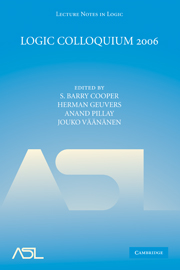Book contents
- Frontmatter
- Contents
- Introduction
- Definability and elementary equivalence in the Ershov difference hierarchy
- A unified approach to algebraic set theory
- Brief introduction to unprovability
- Higher-order abstract syntax in type theory
- An introduction to b-minimality
- The sixth lecture on algorithmic randomness
- The inevitability of logical strength: Strict reverse mathematics
- Applications of logic in algebra: Examples from clone theory
- On finite imaginaries
- Strong minimal covers and a question of Yates: The story so far
- Embeddings into the Turing degrees
- Randomness—beyond Lebesgue measure
- The derived model theorem
- Forcing axioms and cardinal arithmetic
- Hrushovski's amalgamation construction
An introduction to b-minimality
Published online by Cambridge University Press: 28 January 2010
- Frontmatter
- Contents
- Introduction
- Definability and elementary equivalence in the Ershov difference hierarchy
- A unified approach to algebraic set theory
- Brief introduction to unprovability
- Higher-order abstract syntax in type theory
- An introduction to b-minimality
- The sixth lecture on algorithmic randomness
- The inevitability of logical strength: Strict reverse mathematics
- Applications of logic in algebra: Examples from clone theory
- On finite imaginaries
- Strong minimal covers and a question of Yates: The story so far
- Embeddings into the Turing degrees
- Randomness—beyond Lebesgue measure
- The derived model theorem
- Forcing axioms and cardinal arithmetic
- Hrushovski's amalgamation construction
Summary
Abstract. We give a survey with some explanations but no proofs of the new notion of b-minimality by the author and F. Loeser [b-minimality, Journal of Mathematical Logic, vol. 7 (2007), no. 2, pp. 195–227, math.LO/0610183]. We compare this notion with other notions like o-minimality, C-minimality, p-minimality, and so on.
Introduction. As van den Dries notes in his book [17], Grothendieck's dream of tame geometries found a certain realization in model theory, at first by the study of the geometric properties of definable sets for some nice structure like the field of real numbers, and then by axiomatizing these properties by notions of o-minimality, minimality, C-minimality, p-minimality, v-minimality, t-minimality, b-minimality, and so on. Although there is a joke speaking of x-minimality with x = a, b, c, d, …, these notions are useful and needed in different contexts for different kinds of structures, for example, o-minimality is for ordered structures, and v-minimality is for algebraically closed valued fields.
In recent work with F. Loeser [4], we tried to unify some of the notions of x-minimality for different x, for certain x only under extra conditions, to a very basic notion of b-minimality. At the same time, we tried to keep this notion very flexible, very tame with many nice properties, and able to describe complicated behavior.
An observation of Grothendieck's is that instead of looking at objects, it is often better to look at morphisms and study the fibers of the morphisms.
- Type
- Chapter
- Information
- Logic Colloquium 2006 , pp. 91 - 102Publisher: Cambridge University PressPrint publication year: 2009
- 1
- Cited by



